Digital Camera World Verdict
There’s no beating the versatility of a fast standard zoom lens and this Samyang delivers excellent performance with a rapid, virtually silent and consistently accurate autofocus system coupled with great image quality, wrapped up in a robust, weather-sealed construction. And it does so at a very affordable price, compared with own-brand competition. Overall, it’s a bargain buy for Sony E-mount mirrorless cameras.
Pros
- +
Impressive performance
- +
Robust weather-sealed build
- +
Half the price of Sony’s competitor
Cons
- -
No optical stabilization
- -
Fairly stiff zoom ring
- -
Typically chunky and weighty
Why you can trust Digital Camera World
Also badged as ‘Rokinon’, the Samyang AF 24-70mm F2.8 FE is the company’s first ever zoom lens but the manufacturer has certainly hit the ground running. Typical of a ‘trinity’ standard zoom, it combines a classic range of focal lengths with a constant aperture design. Built for Sony full-frame E-mount mirrorless cameras, it also works well on APS-C format bodies, with an ‘effective’ 36-105mm zoom range. That said, it’s typically large and weighs in at just over a kilogram, making it a bit of a hefty proposition for Sony’s smaller cameras. Either way, this Samyang goes head to head with the excellent Sony FE 24-70mm f/2.8 G Master zoom, but costs just half the price.
Specifications
Lens construction: 17 elements in 14 groups
Lens mount: Sony FE
Full frame: Yes
Image stabilization: No
Autofocus: Yes
Angle of view: 85.6-34.4 degrees
Diaphragm blades: 9
Minimum aperture: f/22
Minimum focusing distance: 0.35m
Maximum magnification ratio: 0.1-0.27x
Filter size: 82mm
Dimensions: 88x129mm
Weight: 1,027g
Key features
The Samyang mostly matches the own-brand Sony G Master lens stride for stride. It has an identical zoom range and f/2.8 aperture rating, which remains constant throughout the zoom range. It has a linear stepping motor which is blazing fast for stills and enables smooth autofocus transitions when shooting video, with near-silent operation. For manual focusing in video capture, an electronically controlled ‘par-focal’ function enables the focus distance to remain constant while zooming in and out. As an optional extra for high-end filmmaking, Samyang also offers a Cine Kit for advanced control of the lens when shooting movies.
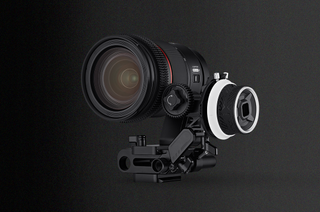
The minimum focus distance of 0.35m is slightly shorter than in the Sony lens, enabling a slightly larger magnification ratio of 0.27x at the long end of the zoom range. A ‘Custom’ dual-mode switch is featured, which is nominally used for switching between autofocus and manual focus, but can be customized to set other functions like aperture control. Samyang says that additional functions will be added in the future, through firmware updates.
Like with the Sony lens, the Samyang lacks an optical image stabilizer, but that’s only really an issue when using first-edition full-frame Alpha mirrorless cameras, and the majority of APS-C bodies, which lack in-body stabilization. The Sony does feature a customizable AF-hold button, which is absent in the Samyang.
There’s no skimping in quality glass. The Samyang features 17 elements in total, including one hybrid aspherical element, two further aspherical elements, three ED (Extra-low Dispersion) elements and three HR (High Refractive index) elements.
Build and handling
Build quality feels very solid and the lens features weather-seals at seven positions, including all joints in the barrel, the ‘Custom’ switch and the mounting plate.
At 1,027g, the Samyang is a little heavier than the Sony, which weighs 886g. The flip side is that the Samyang is a little shorter at 129mm compared with 136mm. Both lenses have a diameter of 88mm and feature an 82mm filter attachment thread, and boast a well-rounded 9-blade aperture diaphragm.
Handling is mostly excellent, our only slight criticism being that the zoom ring of our review sample proved a bit on the stiff side. Zoom creep certainly wasn’t a problem.
Performance
If you’re in the market for a ‘fast’ f/2.8 zoom, attractive bokeh is probably high on your agenda. The Samyang performs well in this respect, with a pretty tight depth of field at longer focal lengths and smooth rendering of defocused areas. Bokeh discs remain well-rounded when stopping down a little, adding to the attraction.
Sharpness is impressive throughout the zoom range, and across the whole image frame. Chromatic aberrations and distortions are well controlled and the lens is resistant to ghosting and flare, aided by the application of Samyang’s Ultra Multi Coating.
Sample images

This pair of shots taken at 70mm shows how sharpness is retained well wide-open at f/2.8, while bokeh remains pleasing when stopping down by an f/stop to f/4, with well-rounded bokeh discs.

This pair of shots taken at 70mm shows how sharpness is retained well wide-open at f/2.8, while bokeh remains pleasing when stopping down by an f/stop to f/4, with well-rounded bokeh discs.





Lab results
We run a range of lab tests under controlled conditions, using the Imatest Master testing suite. Photos of test charts are taken across the range of apertures and zooms (where available), then analyzed for sharpness, distortion and chromatic aberrations.
We use Imatest SFR (spatial frequency response) charts and analysis software to plot lens resolution at the center of the image frame, corners and mid-point distances, across the range of aperture settings and, with zoom lenses, at four different focal lengths. The tests also measure distortion and color fringing (chromatic aberration).
Sharpness:
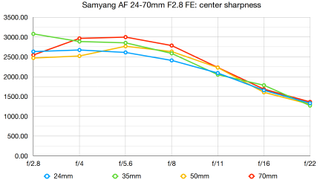
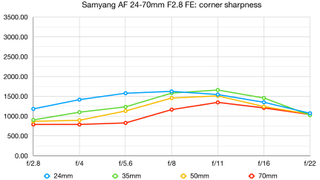
Center sharpness is nothing short of sensational, regardless of focal length, and even when shooting wide open. Inevitably, corner sharpness isn't quite so impressive, but the results at 50mm and 70mm are actually bordering on being poor. It's also worth noting that to get some of the best sharpness scores from this lens, we did have to resort to manual focussing.
Fringing:
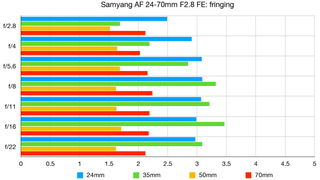
Lateral chromatic aberration is sadly noticable at all focal lengths and aperures, and especially so at shorter focal lengths.
Distortion:
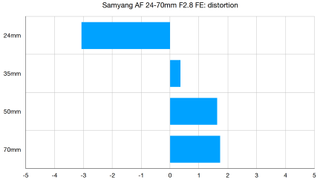
Barrel distortion is obvious at 24mm, though by 35mm it has disappeared, transitioning to moderate pincushion distortion at 50mm and beyond.
Verdict
There’s no beating the versatility of a fast standard zoom lens and this Samyang delivers excellent performance with a rapid, virtually silent and consistently accurate autofocus system coupled with great image quality, wrapped up in a robust, weather-sealed construction. And it does so at a very affordable price, compared with own-brand competition. Overall, it’s a bargain buy for Sony E-mount mirrorless cameras.
Read more:
• Best camera lenses to get
• Best Canon lenses
• Best Nikon lenses
• Best Sony lenses
• Best lenses for Sony A7iii
• Best lenses for Sony A7RIII and A7R IV
• Best lenses for Sony A6000
Matthew Richards is a photographer and journalist who has spent years using and reviewing all manner of photo gear. He is Digital Camera World's principal lens reviewer – and has tested more primes and zooms than most people have had hot dinners!
His expertise with equipment doesn’t end there, though. He is also an encyclopedia when it comes to all manner of cameras, camera holsters and bags, flashguns, tripods and heads, printers, papers and inks, and just about anything imaging-related.
In an earlier life he was a broadcast engineer at the BBC, as well as a former editor of PC Guide.

